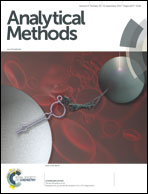Colorimetric sensor for highly sensitive and selective detection of copper ion†
Abstract
The copper ion (Cu2+), as a type of essential element, plays important roles in various metabolic processes of organisms. However, an excessive intake of Cu2+ can induce a series of diseases, such as Alzheimer's disease, Menkes disease and Wilson's disease. Therefore, it is urgently needed to develop an analytical method to achieve a simple and sensitive detection of Cu2+. In this study, a colorimetric sensor for the detection of Cu2+ with a high sensitivity and selectivity has been developed. The design of the colorimetric sensor is based on the inhibiting effect of Cu2+ on the reaction of L-cysteine with our established probe Cy-NB. A significant color change could be directly observed by the naked eye as the concentration of Cu2+ increases. The as-prepared colorimetric sensor has a high sensitivity with a low detection limit of 8.6 nM, and a distinguishing recognition selectivity for Cu2+ over other possibly co-existent metal ions. Moreover, the sensor was successfully utilized for the analysis of tap water, seawater and biosamples, and high recoveries at two spiking levels of Cu2+ ranged from 102 to 114%. The results were consistent with those obtained by ICP-MS, indicating that the developed colorimetric sensor has great application potential as a simple highly sensitive and selective detection method for Cu2+.



 Please wait while we load your content...
Please wait while we load your content...